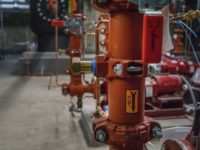HMTX Industries, a family-owned global luxury vinyl tile (LVT) flooring manufacturer, has always placed the human experience at the center of its mission. Serving diverse markets in the construction and renovation industries, HMTX is committed to sustainability, envisioning a future where humans can build, create, and thrive together.
In 2020, HMTX held a design summit to explore impactful actions that could embody their core values as a company. This summit led to the commissioning of a new world headquarters in Norwalk, Connecticut. Designed in alignment with the Living Building Challenge Petal Certification, the most stringent green building rating system in the world, this headquarters was conceptualized as a human-centered space where employees, artists-in-residence, and visitors could find comfort and inspiration.
The ambitious goals for this project presented a unique challenge for the building and mechanical contractors involved: to create the greenest building in Connecticut without sacrificing a single aspect of comfort. In facilities of this scale, the HVAC often contributes 40% of the building’s overall energy consumption. Therefore, HVAC efficiency would be central to the success of the project. Shawmut Design and Construction collaborated with Airzone, a leading HVAC control solution manufacturer, to develop a sophisticated, zoned HVAC system that met HMTX's exacting requirements.
The Challenge
The 24,000-square-foot facility's diverse use of space — from a dramatic three-story atrium and divisible co-working spaces to private offices and design studios — created complex requirements for heating, ventilation, and air conditioning. Some of these spaces, permanently occupied by HMTX employees, needed a consistent level of comfort, while others required a more flexible approach to temperature control.
Adding another layer to the complexity, HMTX had committed to a carbon-zero building in pursuit of the Living Building Challenge (LBC). This commitment meant the building needed to operate using only electricity that could be generated on-site. Furthermore, the LBC demands that the building prioritizes the health and happiness of the occupants, ruling out any energy-saving measures that would compromise their comfort.
“The Living Building Challenge is a relatively new process with extremely stringent requirements,” said Thomas Munson, senior project manager, Shawmut Design and Construction. “It pressed us to start completely fresh in terms of everything from materials sourcing and staging to system design.”
The location of the facility in added yet another dimension to the challenge. The HVAC system needed to adapt to a wide range of temperatures year-round, with average summer highs in the mid-80s and winter lows in the teens. The spring months in Norwalk are particularly unpredictable, often swinging from near-freezing to balmy temperatures in a single day.
To meet the demands of the HMTX project, an HVAC system needed to be extraordinarily adaptive, responsive, and efficient. It needed to provide comfort to a wide range of space types and activities, operate within the constraints of a zero-carbon mandate, and adapt to the highly variable Connecticut weather. This was a tall order, but one that Shawmut was prepared to take on.
The Solution
The HMTX World Headquarters design team took a holistic approach that blended low-tech solutions with state-of-the-art automated systems. The HVAC system leveraged the building's biophilic design, which included passive cooling through operable windows and skylights throughout the facility. The design also incorporated natural light to reduce dependence on electrical lighting, with façade optimization and sunshade louvers. This necessitated an HVAC system that could adapt to varying temperatures in sunnier zones, accounting for additional heat.
An LG VRF Heat Recovery System facility formed the heart of the HMTX HVAC system. The systems consist of 26 ducted units, nine of which are equipped with an Airzone zoning system. Most zones have four to five dampers. In areas where multiple dampers serve the same zone, HTMX has the flexibility to later subdivide the space into multiple zones and control each space independently. Airzone’s patented airflow regulation mechanism enables zoned temperature regulation without the need for a bypass damper, resulting in significant energy savings compared to a traditional VAV system.
“Airzone has been committed to developing sustainable HVAC solutions for decades,” said Victoria Garcia Massimo, national operations manager for Airzone North America. “We’ve created solutions to address every gap where waste creeps in — from plenum mechanisms, to programming, to IoT interoperability. Using these solutions, Airzone customers can realize and energy savings of up to 60%.”
Shawmut used these Airzone controllers to establish seasonal base temperature set points for the entire facility. The set point automatically adjusts throughout the year, enabling the system to operate at peak efficiency. Occupants can further tweak the temperature in specific zones to their preference, ensuring optimal comfort. Unoccupied spaces automatically revert to the baseline temperature after a preset period, further optimizing energy use.
The Airzone controllers integrate via BACnet with the Automated Logic Building Management System responsible for the facility’s overall power management and monitoring, rainwater management, and building automation. This ensures a harmonious, efficient, and sustainable operation of the entire facility, aligning with the goals set for the HMTX World Headquarters.
“This project required a high degree of complex integration between the HVAC and other building systems, and the Airzone team was extremely committed to making that communication work,” Munson said. “In the end, we were able to create a sophisticated HVAC system that was very user-friendly.”
The Results
The HMTX World Headquarters Building officially opened its doors in October 2022. Upon opening, the facility was energy-positive, with over 100% of the building’s power requirements met by solar power gathered using on-site photovoltaic (PV) panels. Owing to the ultra-efficient envelope and mechanical systems of the building, it operates at just 40% of the energy usage intensity of similarly sized and located facilities.
“We needed a very sophisticated solution to accomplish this," said HMTX CEO Harlan Stone. "Our building does not use any electricity from the grid. In addition, we don’t burn any fossil fuel. We are net-zero carbon. All of this is because of the sophisticated HVAC that we have, running entirely on electricity created from the sun and our building.”
Munson regards the project as a serious, but ultimately rewarding design challenge.
“I’d gladly take on another project like this," he said. "It was an incredible learning experience, and a bridge toward our future. The HVAC industry is transitioning toward more energy-efficient systems. We’re seeing more fancoil and VRV systems in commercial applications in lieu of large air-handling units. Ultimately, though, energy management is holistic. It all has to work together.”
This project serves as a beacon of what can be achieved when innovative technology, sustainable practices, and a human-centered approach come together. The HMTX World Headquarters stands not only as a testament to their commitment to sustainability and human comfort but also showcases the possibilities of future-focused HVAC solutions.



